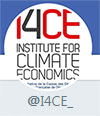10.10.2017
10 minutes of reading
A new report analyses the reform proposals for the EU Emissions Trading System (EU ETS) which are under discussion in the trilogue negotiations between EU institutions, as well as other possible evolutions of the EU ETS in its Phase IV (2021-2030).
The window of opportunity to reform the EU ETS is about to close, with the conclusion of trilogue negotiations between the EU Parliament, the Council and the Commission. I4CE-Institute for Climate Economics- and Enerdata, in collaboration with IFPEN demonstrate in a new report that the EU ETS reform, given the EU Parliament and the EU Council proposals, will not be sufficient to make it a driver of decarbonisation in energy and industry sectors by 2030.
The report “EU ETS- Last call before the doors close on the negotiations for the EU ETS reform” provides an assessment of the EU Parliament and EU Council’s reform proposals, adopted in February 2017. The report looks into greenhouse gases (GHG) emissions reductions, the cost of necessary abatements, the functioning of the Market Stability Reserve (MSR) and the framework of free allocation to industries. Furthermore, the report analyses the impacts of an exit of the UK from the EU ETS, as well as the possible introduction of a price corridor on the EU ETS.
The report demonstrates that:
1- EU Parliament and EU Council’s reform proposals to strengthen the EU ETS fail to make it a driver of decarbonisation in energy and industry sectors over its Phase IV (2021-2030).
- GHG emissions reductions coming notably from energy efficiency and renewable energy policies are sufficient to respect the EU ETS target.
- In spite of the doubling of its withdrawal rate in the first years of its functioning, the MSR is not able to mitigate the effect of renewable energy and energy efficiency policies on the EU ETS.
2- However, the EU ETS requires a drastic decrease in GHG emissions in the long terms.
- The EU ETS trajectory is aligned on the low end of long-term EU climate ambition. Furthermore, long-term EU climate objectives and the EU ETS trajectory should now be updated to integrate the objectives of the Paris Agreement.
- Only the anticipation of EU long-term climate objectives will result in a sustainable and politically acceptable decarbonisation pathway.
- In that context, an EU-wide price corridor on the EU ETS could be one solution to the lack of anticipation of ETS operators and would lead to earlier mitigation efforts in ETS sectors.
3- A possible exit of the UK from the EU ETS adds to the uncertainty of the current revision of the EU ETS directive. In that case, careful attention should be paid to the adaptation of the emissions cap and the MSR parameters.
4- The framework for free allocation to prevent carbon leakage[1] risks in industrial sectors is a focal point in the negotiations on the EU ETS reform.
- The proposals of the Council and the Parliament on the EU ETS reform will probably result in a Cross-Sectoral Correction Factor (CSCF) triggered at the end of Phase IV, under conservative assumptions for benchmark decrease rates in major sectors covered by the EU ETS -refinery, cement, aluminum, steel. This factor adjusts the total free allocation for eligible installations to the EU free allocation cap.
- Quantifying the impact of EU ETS design parameters on the demand or on the supply of free allowances enables to evaluate how to avoid triggering the CSCF, keeping in mind that free allocation should not result in windfall profits and is meant to be a transitional tool.
- With an harmonization over the EU ETS of the compensation of indirect costs in electro-intensive sectors, around 24% of EUAs auctioning volumes would be required over Phase IV to compensate indirect costs in the main eligible sectors.
5- The EU ETS needs to be assessed along with other climate and energy policies.
- Unless an unexpected proposal comes out of the trilogue negotiation, the revised EU ETS directive will not be sufficient to make the EU ETS more resilient to the effect of other climate and energy policies on the supply-demand balance of the market.
- The negotiations on other pieces of the 2030 climate and energy framework, and in particular on the proposed regulation on the Governance of the Energy Union, thus appear as an opportunity to create a consistent policy mix and manage the interactions between the different policy instruments.
Enerdata modelled different scenarios for the design of the EU ETS, with a long-term perspective until 2040, using their global energy system simulation model (POLES). Cyril CASSISSA, project manager at Enerdata points out that “the interaction between the different EU objectives (the reduction of GHG emissions, the deployment of renewable energy sources and energy efficiency measures) has a significant impact on the functioning of the EU ETS. Taking into account the objectives for renewable energy sources and energy efficiency shows that the EU ETS will not be effective over its Phase IV."
Consequently, Charlotte VAILLES, project manager at I4CE, specifies that “the reform proposals from the EU Parliament and the EU Council, even if they are more ambitious than the initial proposal from the EU Commission, will not be sufficient to re-balance the EU ETS by 2030. The doubling of the MSR intake rate will be essential, but the decarbonisation of energy and industry sectors in the EU will require a better coordination of the interactions between the different pieces of the 2030 climate and energy package."
Finally, Paula COUSSY, expert on CO2 markets at IFPEN, confirms, based on her analysis of climate and energy policies in the refining sector, that “in the refining sector, covered by the EU ETS, we estimate that GHG emissions reductions realized by 2030 through energy efficiency gains and the upgrade of utility systems will be counterbalanced by an increase in emissions coming from the production of low-sulfur maritime fuels, following the International Maritime Organization’s regulation.”
This report was produced within the framework of the research program COPEC II (COordination of EU Policies for Energy and CO2 by 2030) launched in April 2017. The research program received financial support from public and private sponsors, and was carried out independently by I4CE, in collaboration with IFPEN. The authors take sole responsibility for findings or ideas presented in this report as well as any errors or omissions. Sponsors are not by any means responsible for the content of this publication.
[1] Risk of a transfer of industrial production to a country with laxer climate policies.
publications
Report (33 pages) :
>> EU ETS: last call before the doors close on the negotiations for the post-2020 reform - Assessment of options to reform the EU ETS
Full Report (52 pages) :
>> EU ETS: last call before the doors close on the negotiations for the post-2020 reform
+ For more information on our publications, events,
>> subscribe to our newsletter (I4CE) and to Enerdata's.
+ Follow us on Twitter:

|

|

|

|
Program team
I4CE's Contact
Charlotte VAILLES - charlotte.vailles @i4ce.org
Enerdata's Contact
Cyril CASSISA - cyril.cassisa@enerdata.net
IFPEN's Contact
Paula COUSSY - paula.coussy@ifpen.fr








